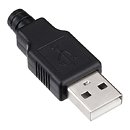Tuesday, September 3rd 2019
USB-IF Announces Publication of USB4 Specification
USB Implementers Forum (USB-IF), the support organization for the advancement and adoption of USB technology, today announced the publication of the USB4 specification, a major update to deliver the next-generation USB architecture that complements and builds upon the existing USB 3.2 and USB 2.0 architectures. The USB4 architecture is based on the Thunderbolt protocol specification recently contributed by Intel Corporation to the USB Promoter Group. It doubles the maximum aggregate bandwidth of USB and enables multiple simultaneous data and display protocols.
The development of the USB4 specification was first announced in March 2019 by the USB Promoter Group. It is now officially published by USB-IF and available for download here.Key characteristics of the USB4 solution include:
The upcoming USB Developer Days 2019 will include detailed technical training covering the USB4 specification and the latest for USB Type-C, USB Power Delivery, and new USB-IF branding strategies.
The development of the USB4 specification was first announced in March 2019 by the USB Promoter Group. It is now officially published by USB-IF and available for download here.Key characteristics of the USB4 solution include:
- Two-lane operation using existing USB Type-C cables and up to 40 Gbps operation over 40 Gbps certified cables
- Multiple data and display protocols that efficiently share the maximum aggregate bandwidth
- Backward compatibility with USB 3.2, USB 2.0 and Thunderbolt 3
The upcoming USB Developer Days 2019 will include detailed technical training covering the USB4 specification and the latest for USB Type-C, USB Power Delivery, and new USB-IF branding strategies.

13 Comments on USB-IF Announces Publication of USB4 Specification
Printers are actually type-B, but yeah, most other things are type-A still and so are most of the ports on brand new motherboards.
Just be thankful that the server and gaming markets are separate: they're still using serial ports!
I always pick the wrong side.......so I guess it takes 3-4 try's; cuz you got to double check twice just to make sure....then try once more before you feel you
have safely connected the USB Type A connector in correctly....
Don't get me started on Firewire 400.......
Maybe the issue is me? hmmmm..........
Only USB 3.1 Gen 2 still is not widely used.
USB 2.0 and USB 3.0 are most popular.
I have USB 3.1 Gen 2 Connector on front panel of case. He is easy removable because WX version of case had only hole, and WXC have and connector removable with 2 screws from other side.
If Lian Li launch USB4 connector I will regulary replace him. Probably will work same for PC-O11 classic and PC-O11 Dynamic/Air.
USB 3.0 above I use for Logitech Unifying Receiver for G900.
The issue is they haven't made any progress until type-c... 20 years later.
Also, this needs to never happen again: